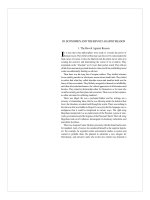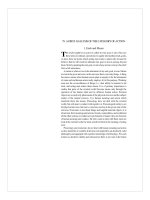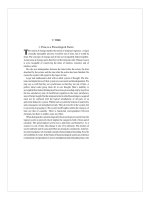Group counseling strategies and skills chapter 2
Bạn đang xem bản rút gọn của tài liệu. Xem và tải ngay bản đầy đủ của tài liệu tại đây (421.04 KB, 17 trang )
Copyright © 2012 Brooks/Cole, a division of Cengage Learning, Inc.
Stages of Groups, Group Process,
and Therapeutic Forces
©2016. Cengage Learning. All rights reserved.
Chapter 2
– The Working Stage
– The Closing Stage
Copyright © 2012 Brooks/Cole, a division of Cengage Learning, Inc.
All groups go through three stages:
– The Beginning Stage
©2016. Cengage Learning. All rights reserved.
Stages of Groups
Tuckman: forming, storming, norming,
performing, and adjourning.
Copyright © 2012 Brooks/Cole, a division of Cengage Learning, Inc.
Corey: formation, orientation, transition,
working, consolidation, and follow-up.
©2016. Cengage Learning. All rights reserved.
Other Models of Sequential Stages
Dynamics of Interaction Patterns
– Who talks to whom and how often do
members speak?
– Is the interaction member to member or
member to leader?
Copyright © 2012 Brooks/Cole, a division of Cengage Learning, Inc.
Group process: interaction and energy
exchange among members and leaders.
©2016. Cengage Learning. All rights reserved.
Group Process
Members have different abilities to learn
Members at different comfort levels with the
material
– Discussion Groups
Leader needs to be aware of member trying to
dominate
Leader should try to get everyone to participate
Copyright © 2012 Brooks/Cole, a division of Cengage Learning, Inc.
A discussion of group dynamics must take
into consideration the kind of group and the
leadership style
– Education Groups
©2016. Cengage Learning. All rights reserved.
Group Dynamics of Different Kinds
of Groups
– Task Groups
Members may need conflict-resolution
Be aware of power plays
– Growth & Experiential Groups
Most important is how members feel about each
other since they will be sharing personally
Wide variety of needs among members
Copyright © 2012 Brooks/Cole, a division of Cengage Learning, Inc.
continued
©2016. Cengage Learning. All rights reserved.
Group Dynamics of Different Kinds
of Groups
– Support Groups
Level of trust, commitment, and caring is essential
Need for commonality
– Counseling & Therapy Groups
Members at different levels of mental health
Members have wide variety of needs
– Self-Help Groups
No identified leader
Dynamics vary depending on membership
Copyright © 2012 Brooks/Cole, a division of Cengage Learning, Inc.
continued
©2016. Cengage Learning. All rights reserved.
Group Dynamics of Different Kinds
of Groups
Copyright © 2012 Brooks/Cole, a division of Cengage Learning, Inc.
Instillation of hope
Universality
Imparting of information
Altruism
Corrective recapitulation of the primary
family group
©2016. Cengage Learning. All rights reserved.
Yalom’s Curative Factors
Development of socialization techniques
Imitative behavior
Interpersonal learning Group cohesiveness
Catharsis
Existential factors
Copyright © 2012 Brooks/Cole, a division of Cengage Learning, Inc.
continued
©2016. Cengage Learning. All rights reserved.
Yalom’s Curative Factors
Clarity of Purpose
– Leader needs to be clear
– Members need to be clear
Relevance of Purpose
– Must fit the purpose of the group
Copyright © 2012 Brooks/Cole, a division of Cengage Learning, Inc.
A skilled leader is always paying attention to
the therapeutic forces in a group.
©2016. Cengage Learning. All rights reserved.
Therapeutic Forces
Group Size
– Depends on the kind of group
– 5-8 members usually best
– Educational groups can be larger
Copyright © 2012 Brooks/Cole, a division of Cengage Learning, Inc.
continued
©2016. Cengage Learning. All rights reserved.
Therapeutic Forces
Length of Each Session
– Depends on kind of group
– Varies with members
– Discussion, Education, 1-2 hours
– School groups—20-40 minutes
– Support, Counseling, Therapy groups 11/2-2
hours
Copyright © 2012 Brooks/Cole, a division of Cengage Learning, Inc.
continued
©2016. Cengage Learning. All rights reserved.
Therapeutic Forces
Frequency of meetings
– Depends on setting and purpose
Daily – residential setting,
counseling/therapy
Weekly- residential or community
setting, counseling/therapy, support
Bi-weekly-community, support,
psychoeducational
Copyright © 2012 Brooks/Cole, a division of Cengage Learning, Inc.
continued
©2016. Cengage Learning. All rights reserved.
Therapeutic Forces
Adequacy of the Setting
– Be prepared for inadequate places to conduct groups
– Ideally, a private space with the same size chairs
Time of Day
– Convenient for leaders and members
– After lunch is often difficult—members are sleepy
The Leader’s Attitude
– Member’s definite pick up the positive or negative
attitude of the leader
Copyright © 2012 Brooks/Cole, a division of Cengage Learning, Inc.
continued
©2016. Cengage Learning. All rights reserved.
Therapeutic Forces
Closed or Open Groups
– Open groups are more difficult
New members come
Members leave
Members can’t get as close
Voluntary or Nonvoluntary
Membership
– It is usually an anti-therapeutic force
at the beginning with nonvoluntary
members
Copyright © 2012 Brooks/Cole, a division of Cengage Learning, Inc.
continued
©2016. Cengage Learning. All rights reserved.
Therapeutic Forces
Member’s Level of Commitment
Level of Trust
– The leader is crucial in the development of
trust in a group
Member’s Attitudes Toward the Leader
The Leader’s Experience in leading Groups
Coleadership Harmony
Copyright © 2012 Brooks/Cole, a division of Cengage Learning, Inc.
continued
©2016. Cengage Learning. All rights reserved.
Therapeutic Forces
Copyright © 2012 Brooks/Cole, a division of Cengage Learning, Inc.
Balance process vs. content. A common
mistake is to focus too much on one or the
other.
– Process here refers to the group dynamics,
and therapeutic forces
– Content refers to the purpose or task of the
group
©2016. Cengage Learning. All rights reserved.
Process And Content









